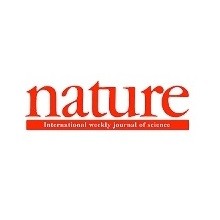
انتقال DNA از طریق نانو حفره هیدروفیلیک در نیترید بور شش ضلعی
نانوحفره حالت جامد خیلی نازک با ویژگی جذب آب خوب ، برای دستیابی به وضوح فضایی برنامه های کاربردی متوالی DNA مناسب هستند. لایه ی بور نیترید شش ضلعی (h-BN) با ضخامت اتمی، یک ماده دو بعدی را برای ایجاد نانوحفره های حالت جامد ارائه می دهد. با توجه به مقاومت خوب آن در برابر اکسایش، خصلت هیدروفیلیک دستگاه نانوحفره h-BN می تواند به طور قابل توجهی توسط درمانUV-ozone بهبود یابد. زاویه تماس یک ریز قطره KCl-TE در لایه h-BN می تواند بعد از برخورد از 57^° به 26^° کاهش یابد. رویدادهای بسیاری از انتقال DNA در چنین دستگاه هایی مشاهده شده و بر هم کنش قوی نانو حفره DNA را در حفره هایی با قطر کمتر از 10 نانومتر آشکار می سازد. سطح نویز 1 / f تقریبا به ناحیه ی لایه h-BN معلق مرتبط شده و بطور قابل توجهی کاهش یافته در پنجره پشتیبانی کوچکتر است. عملکرد نشان داده شده در نانو حفره ی h-BN، راه تشخیص یک مولکولDNA منفرد را هموار می کند.
به عنوان یکی از امید بخش ترین تصورات، دنباله ی DNA با نانو حفره از سال 1996 توجه زیادی را به خود جلب کرده است.1 انتقال DNA 1-3و تشخیص پایه 4 در ایجاد نانوحفره های زیست شناختی از پروتئین های خاص شرح داده شده است. با این حال، نانوحفره های حالت جامد، برای ثبات بیشتر، و ادغام دستگاههای ساده تر ارجح ترند. اولین نانوحفره های حالت جامد در غشاهای سیلیکون نیترید (Si_3 N_4) ساخته شده اند که دارای ضخامت ده ها نانومتری هستند5، و پیشرفت قابل توجهی در تشخیص انتقال DNA صورت گرفته است7و6 و جنبش DNA در چنین دستگاههای نانوحفره ای کنترل می شود8. برای دستیابی به تشخیص پایه در یک مولکول DNA مفرد، ضخامت موثر نانوحفره حالت جامد باید به کمتر از نانومتر کاهش یابد. بدین منظور، لایه های گرافین با ضخامت اتمی در ساخت دستگاه های نانو حفره با وضوح بالا و حساسیت هندسی استفاده شده اند 12-9. از سوی دیگر، خاصیت هیدروفیلیک نانوحفره برای جلوگیری از انسداد با توجه به تعامل هیدروفوبیک(آب گریزی) معمولی با DNA عملا مهم است. اخیرا، هیدروفیلیک گرافین نانوحفره ها با ته نشین شدن لايه اتمي دي اکسيد تيتانيوم 11 و پوشش هيدروفيلیک خود آرا 13بهبود يافته است، با این حال ضخامت موثر حفره ها را افزایش می دهد. انواع جدید نانوحفره های ضخیم اتمی با خاصیت هیدروفیلیک بالا هنوز هم بسیار مطلوب هستند.
Ultra-thin solid-state nanopore with good wetting property is strongly desired to achieve high spatial resolution for DNA sequencing applications. Atomic thick hexagonal boron nitride (h-BN) layer provides a promising two-dimensional material for fabricating solid-state nanopores. Due to its good oxidation resistance, the hydrophilicity of h-BN nanopore device can be significantly improved by UV-Ozone treatment. The contact angle of a KCl-TE droplet on h-BN layer can be reduced from 576 to 266 after the treatment. Abundant DNA translocation events have been observed in such devices, and strong DNA-nanopore interaction has been revealed in pores smaller than 10 nm in diameter. The 1/f noise level is closely related to the area of suspended h-BN layer, and it is significantly reduced in smaller supporting window. The demonstrated performance in h-BN nanopore paves the way towards base discrimination in a single DNA molecule.
As one of the most promising concepts, DNA sequencing with nanopore has attracted a lot of attention since 19961 . DNA translocation1–3 and base discrimination4 has been demonstrated in biological nanopores made of specific proteins. Solid-state nanopores, however, are strongly preferred for higher stability and easier device integration. The first solid-state nanopores are fabricated in silicon nitride (Si3N4) membranes that are tens of nanometers thick5 , and significant progress has been made in detection of DNA translocation6,7, and DNA motion control8 in such nanopore devices. To achieve base discrimination in a single DNA molecule, the effective thickness of a solid-state nanopore has to be reduced down to sub-nanometer. For such propose, atomic thick graphene layers has been employed in fabricating nanopore devices featured with high resolution and geometrical sensitivity9–12. On the other hand, the hydrophilicity of nanopore is practically important to avoid clogging due to strong nonspecific hydrophobic interaction with DNA. Recently, the hydrophilicity of graphene nanopores has been improved by atomic-layer deposition of titanium dioxide11 and self-assembled hydrophilic coating13, which however increases the effective thickness of the pores. New types of atomic thick nanopores with high hydrophilicity are thus still strongly desired.
نتایج
بحث
متدها
Results
Discussion
Methods
- ترجمه فارسی مقاله با فرمت ورد (word) با قابلیت ویرایش، بدون آرم سایت ای ترجمه
- ترجمه فارسی مقاله با فرمت pdf، بدون آرم سایت ای ترجمه
